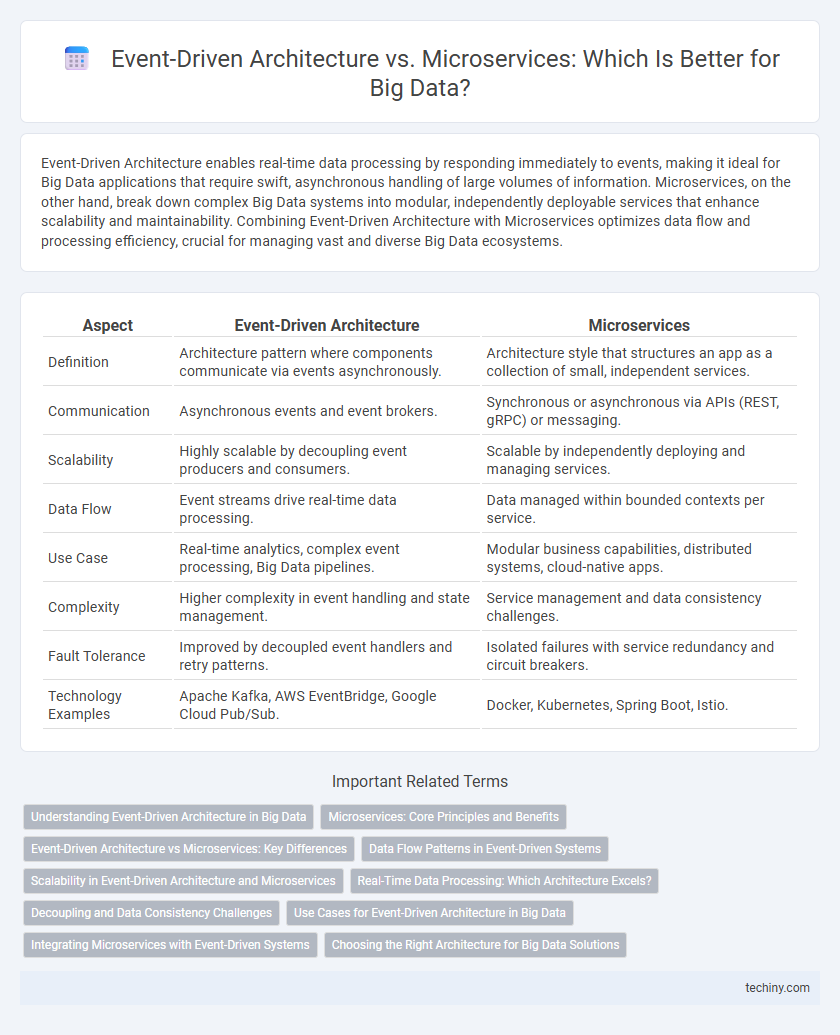Event-Driven Architecture enables real-time data processing by responding immediately to events, making it ideal for Big Data applications that require swift, asynchronous handling of large volumes of information. Microservices, on the other hand, break down complex Big Data systems into modular, independently deployable services that enhance scalability and maintainability. Combining Event-Driven Architecture with Microservices optimizes data flow and processing efficiency, crucial for managing vast and diverse Big Data ecosystems.
Table of Comparison
| Aspect | Event-Driven Architecture | Microservices |
|---|---|---|
| Definition | Architecture pattern where components communicate via events asynchronously. | Architecture style that structures an app as a collection of small, independent services. |
| Communication | Asynchronous events and event brokers. | Synchronous or asynchronous via APIs (REST, gRPC) or messaging. |
| Scalability | Highly scalable by decoupling event producers and consumers. | Scalable by independently deploying and managing services. |
| Data Flow | Event streams drive real-time data processing. | Data managed within bounded contexts per service. |
| Use Case | Real-time analytics, complex event processing, Big Data pipelines. | Modular business capabilities, distributed systems, cloud-native apps. |
| Complexity | Higher complexity in event handling and state management. | Service management and data consistency challenges. |
| Fault Tolerance | Improved by decoupled event handlers and retry patterns. | Isolated failures with service redundancy and circuit breakers. |
| Technology Examples | Apache Kafka, AWS EventBridge, Google Cloud Pub/Sub. | Docker, Kubernetes, Spring Boot, Istio. |
Understanding Event-Driven Architecture in Big Data
Event-Driven Architecture (EDA) in Big Data enables real-time processing by capturing and responding to data events as they occur, enhancing system responsiveness and scalability. Unlike microservices that focus on modularizing business functions, EDA prioritizes asynchronous communication through event streams, enabling efficient handling of high-velocity and high-volume data. This approach optimizes data ingestion, streaming analytics, and event sourcing, critical for dynamic big data ecosystems.
Microservices: Core Principles and Benefits
Microservices architecture emphasizes building applications as a collection of small, independent services that communicate through APIs, enabling scalability and flexibility in Big Data environments. Core principles include decentralization of data management, independent deployment, and continuous delivery, which enhance resilience and speed up development cycles. This approach improves fault isolation and allows organizations to leverage diverse technologies tailored to specific service requirements, maximizing performance and adaptability.
Event-Driven Architecture vs Microservices: Key Differences
Event-Driven Architecture (EDA) centers on asynchronous event processing, enabling real-time data flow and responsiveness crucial for Big Data environments, while Microservices architecture organizes applications into loosely coupled, independent services that focus on modularity and scalability. The key difference lies in their communication patterns: EDA relies on event producers and consumers with messaging systems like Kafka or RabbitMQ, facilitating decoupled service interaction, whereas Microservices typically use synchronous REST APIs or gRPC for direct communication. EDA's design optimizes for scalable, event-centric workflows in dynamic Big Data processing, whereas Microservices emphasize service autonomy and independent deployment within distributed systems.
Data Flow Patterns in Event-Driven Systems
Event-Driven Architecture (EDA) leverages asynchronous data flow patterns, where events trigger communication between decoupled components, enabling real-time processing and scalability in Big Data environments. Microservices implement fine-grained services that communicate via events or APIs, emphasizing autonomy and flexibility in data handling. In event-driven systems, data flows through event brokers or message queues, facilitating loose coupling and enhancing resilience in distributed Big Data applications.
Scalability in Event-Driven Architecture and Microservices
Event-Driven Architecture enhances scalability by decoupling components through asynchronous event processing, allowing independent services to scale dynamically based on event load. Microservices achieve scalability by isolating functionalities into discrete services that can be independently deployed and scaled horizontally. Combining Event-Driven Architecture with Microservices optimizes resource usage and responsiveness, enabling systems to handle high data volume and velocity effectively.
Real-Time Data Processing: Which Architecture Excels?
Event-Driven Architecture (EDA) excels in real-time data processing by enabling asynchronous event handling and immediate reaction to data streams, which is crucial for time-sensitive Big Data applications. Microservices, while modular and scalable, often rely on synchronous communication that can introduce latency in real-time scenarios. Combining EDA with microservices can optimize real-time processing by leveraging event-driven communication within loosely coupled, independently deployable services.
Decoupling and Data Consistency Challenges
Event-Driven Architecture (EDA) enhances decoupling by allowing independent event producers and consumers to interact asynchronously, reducing direct dependencies between microservices. Microservices architectures face data consistency challenges due to distributed data management, often requiring eventual consistency models and complex event orchestration to maintain data integrity. The combination of EDA with microservices improves scalability and responsiveness but demands robust strategies for handling data synchronization and consistency across distributed services.
Use Cases for Event-Driven Architecture in Big Data
Event-Driven Architecture (EDA) excels in Big Data scenarios requiring real-time data processing and analytics, such as fraud detection, IoT sensor data analysis, and dynamic pricing models. EDA efficiently handles asynchronous data streams and decouples services, enabling scalable and responsive systems that process vast volumes of data with minimal latency. These capabilities make EDA ideal for use cases involving continuous data ingestion, complex event processing, and immediate reaction to changing data patterns.
Integrating Microservices with Event-Driven Systems
Integrating microservices with event-driven architecture enhances scalability and real-time data processing by enabling asynchronous communication through events. Event brokers like Apache Kafka or RabbitMQ facilitate decoupled service interactions, improving fault tolerance and system responsiveness. This combination supports Big Data environments by efficiently managing high-throughput event streams and complex data pipelines.
Choosing the Right Architecture for Big Data Solutions
Event-Driven Architecture excels in handling high-velocity data streams by enabling real-time processing and asynchronous communication, making it ideal for dynamic Big Data environments requiring rapid event handling. Microservices architecture offers modularity and scalability by decomposing applications into independent services, facilitating easier development, deployment, and management of complex Big Data workflows. Selecting between Event-Driven Architecture and Microservices depends on the need for real-time data responsiveness versus service-oriented modularity in Big Data solutions.
Event-Driven Architecture vs Microservices Infographic

 techiny.com
techiny.com